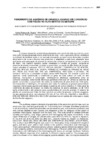Por favor, use este identificador para citar o enlazar este ítem:
http://www.alice.cnptia.embrapa.br/alice/handle/doc/910284| Título: | Rendimento de aquênios de girassol quando em consórcio com feijão no Alto Sertão de Sergipe. |
| Autor: | OLIVEIRA, I. R. de  CARVALHO, H. W. L. de   CASTRO, C. R.   RODRIGUES, C. S.   MENEZES, V. M. M.   CARVALHO, L. M. de   CARVALHO, C. G. P.   |
| Afiliación: | IVENIO RUBENS DE OLIVEIRA, DTT HELIO WILSON LEMOS DE CARVALHO, CPATC CAMILA RODRIGUES CASTRO CINTHIA SOUZA RODRIGUES, PIBIQ-CNPQ VANESSA MARISA MIRANDA MENEZES, PIBIQ/CNPQ LUCIANA MARQUES DE CARVALHO, CPATC CLAUDIO GUILHERME PORTELA CARVALHO, CNPSO. |
| Año: | 2011 |
| Referencia: | In: REUNIÃO NACIONAL DE PESQUISA DE GIRASSOL, 19., 2011, Aracaju. Anais... Londrina: Embrapa Soja Aracaju: Embrapa Tabuleiros Costeiros, 2011. |
| Páginas: | p. 229-232. |
| Descripción: | O girassol apresenta características desejáveis sob o ponto de vista agronômico, como ciclo curto, elevada qualidade e bom rendimento em óleo. Para a agricultura familiar nordestina a produção de biodiesel ainda é um mercado emergente que gera novas demandas de grãos de girassol e de novas cultivares mais produtivas e adaptadas a cada local, adaptação essa que passa pela adequação do girassol ao sistema de consórcio, principalmente com a cultura do feijão. Este trabalho objetivou validar variedades e híbridos de girassol, utilizando-se sistemas de plantio consorciado ao feijão e monocultivo, na região do Alto Sertão de Sergipe. Foram utilizadas 20 cultivares: NTO 2.0, NTO 3.0, AGUARÁ 4, AGUARÁ 6, M 734, BRS 321, BRS 322, BRS 323, BRS G 26, OLISUN, PARAISO 22, PARAISO 33, PARAISO 65, HELIO 251, HELIO 253, HELIO 863, BRS 324, EMBRAPA122, MULTISSOL e CATISSOL. No consórcio utilizou-se a variedade de feijão carioca BRS Requinte. Foi avaliado o peso dos aquênios, sendo estabelecido o rendimento de grãos de cada cultivar em cada um dos sistemas, monocultivo e consorciado. Verificaram-se diferenças significativas entre as cultivares avaliadas, evidenciando diferenças genéticas entre elas em ambos os sistemas de plantio, monocultivo e consorciado. Na média, os rendimentos de grãos foram de 1.834 kg/ha, em monocultivo e 1.853 kg/ha, em consórcio com feijão. As cultivares de girassol apresentaram respostas diferenciadas quando submetidas a sistemas de cultivos distintos. A média geral de rendimento de grãos de girassol, na média dos sistemas de plantio adotados, foi de 1.843 kg/ha evidenciando o alto potencial para a produtividade do conjunto avaliado. O sistema de plantio em consórcio com feijão foi mais favorável ao cultivo do girassol no Sertão sergipano, no ano agrícola de 2010. As cultivares NTO 3.0, M 734, NTO 2.0, AGUARÁ 4, AGUARÁ 6, BRS 323, BRS 322, BRS G 26 e HELIO 253 constituem-se em opções de cultivo para a região do Alto Sertão sergipano. INTERCROPPING OF SUNFLOWER WITH CASSAVA IN THE COASTAL TABLELAND ECOREGION OF BRAZIL. The sunflower presents desirable characteristics in the agronomic point of view, such as short cycle, high yield and good quality oil. To the family farm northeast of biodiesel production is still an emerging market that generates new demands for grain and sunflower production and new cultivars adapted to each location, this adaptation is that the adequacy of the system of sunflower intercropping, especially with the bean crop. This study aimed to validate sunflower varieties and hybrids, using tillage systems and intercropping with beans monoculture, in the Upper Wilderness of Sergipe. 20 cultivars were used: NTO 2.0, NTO 3.0, Aguará 4, Aguará 6, M 734, BRS 321, BRS 322, BRS 323, BRS 26 G, OLISUN, Paraiso 22, Paraiso 33, Paraiso 65, HELIO 251, HELIO 253, HELIO 863, BRS 324, EMBRAPA122, MULTISSOL and CATISSOL. The variety of bean BRS Requinte was used in the intercroping. It was evaluated the weight of grains, and laid a grain yield of each cultivar in the systems, monoculture and intercropping. There were significant differences among cultivars, indicating genetic differences between them in both cropping systems, monoculture and intercropping. The grain yields were 1,834 kg/ha in monoculture and 1,853 kg/ha in the intercropping with beans, on average. Sunflower Cultivars showed different responses when subjected to different cropping systems. The average grain yield of sunflower in the middle of the cropping systems adopted, was 1,843 kg/ha showed the high potential productivity for all evaluated. The planting system in intercropping with beans was more favorable to the cultivation of sunflower in Sergipe, in the agricultural year 2010. The Cultivars NTO 3.0, M 734, NTO 2.0, Aguará 4, Aguará 6, BRS 323, BRS 322, BRS G26 and HELIO 253 are good options to cultivation for the semiarid region of Sergipe. |
| Thesagro: | Girassol |
| Tipo de Material: | Artigo em anais e proceedings |
| Acceso: | openAccess |
| Aparece en las colecciones: | Artigo em anais de congresso (CNPSO)  |
Ficheros en este ítem:
| Fichero | Descripción | Tamaño | Formato | |
|---|---|---|---|---|
| 229232.pdf | 103,92 kB | Adobe PDF |  Visualizar/Abrir |









